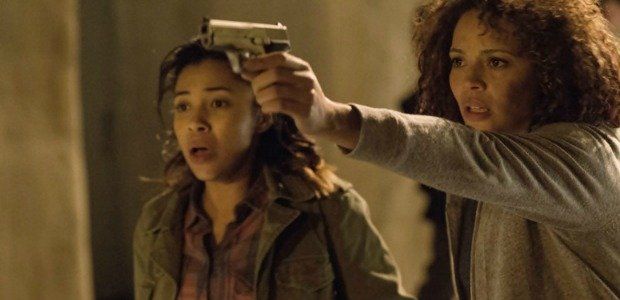Watching the first 20 minutes or so of The Purge: Anarchy, I was rather impressed. From the way the story was developing, it appeared that the filmmakers had taken the most frequent criticism of the first movie to heart and had opened up the world of The Purge by creating an anthology film following three very different scenarios: a man (Frank Grillo) who is hunting for bloody revenge and willfully goes out during the night; a waitress (Carmen Ejogo) and her daughter (Zoe Soul) trying to stay safe in their low-rent housing; and a couple (Zach Gilford. Kiele Sanchez) who find that their car has been sabotaged just as the warning bells are going off.
Had writer/director James DeMonaco chosen to keep these stories separate and really explored how The Purge effects people from all different angles, the movie could have been a real success – building on what is already an interesting sci-fi world. Instead, all of the characters are united through happenstance after that approximate 20 minute mark, and unfortunately the rest of the movie develops into the most basic survival horror story you can imagine. All originality in the initial premise is snuffed out by what ends up being a rather predictable plot made all the more tepid by a complete lack of any real effective scares.
It’s entirely likely that The Purge: Anarchy was handcuffed by a very small budget kept in check to make sure that the final product would be profitable, but it’s still frustrating that a world that opens up so many horror possibilities as The Purge still hasn’t been effectively explored. While there certainly is a good amount of violence in the movie, it never gets to the point of being either shocking or overly brutal – which severely limits its overall effectiveness. What’s more, so much emphasis is put on murder that it shortchanges the fact that all crime is legal in the world of The Purge. The rules of the film really allow for all kinds of psychotic chaos, but none of it is capitalized on effectively. Given the overall message from the larger metaphor at play, this is a series that should be effectively punishing the audience for finding brutality and horror entertaining, similar to the story’s villains. but it never steps up to the plate.
Like the plot, the cast of The Purge: Anarchy as an ensemble is ultimately rather uninspiring, but the real and honest exception is Frank Grillo. Playing an unnamed military-type simply known as Sergeant, the veteran character actor demonstrates a great deal of screen presence while also effectively shrouding his damaged character in mystery, constantly making the audience want to know more about him. It’s unfortunate that he winds up being handcuffed to such a bland group of strangers, because an entire movie just following him on his search for entirely legal but morally questionable revenge could have been great.
Much like the first movie, The Purge: Anarchy sets up a surprisingly interesting scenario and world, but simply bungles its execution – perhaps due to a fundamental misunderstanding of the potential in the first place. Between the social class allegories, the opportunity for a true horror show, and the chance to construct interesting characters evolved from a purging world, this remains a franchise with promise but as of yet no great delivery.

Eric Eisenberg is the Assistant Managing Editor at CinemaBlend. After graduating Boston University and earning a bachelor’s degree in journalism, he took a part-time job as a staff writer for CinemaBlend, and after six months was offered the opportunity to move to Los Angeles and take on a newly created West Coast Editor position. Over a decade later, he's continuing to advance his interests and expertise. In addition to conducting filmmaker interviews and contributing to the news and feature content of the site, Eric also oversees the Movie Reviews section, writes the the weekend box office report (published Sundays), and is the site's resident Stephen King expert. He has two King-related columns.
Most Popular




